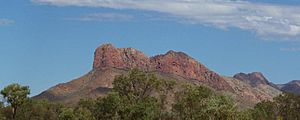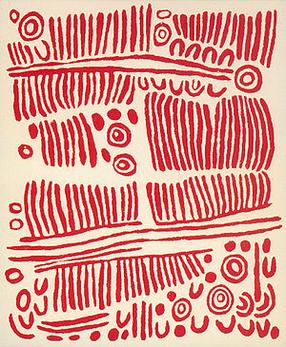Wintjiya Napaltjarri facts for kids
Quick facts for kids
Wintjiya Napaltjarri
|
|
|---|---|
| Born | ca. 1923 to 1934 North-west of Kintore, Northern Territory
|
| Nationality | Australian |
| Known for | Painting |
| Awards | Finalist, National Aboriginal & Torres Strait Islander Art Award: 2007, 2008 |
Wintjiya Napaltjarri (born sometime between 1923 and 1934) is an amazing Indigenous Australian artist. She speaks the Pintupi language and comes from the Western Desert region of Australia. Her name is sometimes spelled Wentjiya, Wintjia or Wentja. She is also known as Wintjia Napaltjarri No. 1.
Wintjiya is the sister of another artist, Tjunkiya Napaltjarri. Both sisters were married to Toba Tjakamarra. Wintjiya and Toba had five children together.
Wintjiya started creating contemporary Indigenous Australian art in 1994. This was at a place called Haasts Bluff. She worked on a group painting project and made batik fabrics. She has also created art using a method called drypoint etching.
Her paintings often show symbols that look like the eggs of the flying ant (called waturnuma). She also paints designs representing hair-string skirts (called nyimparra). Wintjiya often uses strong red or black colors against a white background in her art.
Wintjiya was a finalist for a big art prize, the National Aboriginal & Torres Strait Islander Art Award, in 2007 and 2008. Her artwork is kept in many important art collections in Australia. These include the Art Gallery of New South Wales and the National Gallery of Australia. Her art is also displayed in the Kluge-Ruhe Aboriginal Art Collection at the University of Virginia in the United States.
Contents
About Wintjiya's Life
It's a bit tricky to know Wintjiya's exact birth year. Some sources say around 1923, while others suggest 1932 or 1934. This is because Indigenous Australians sometimes think about time differently. They might estimate dates by comparing them to other important events.
Wintjiya has a "skin name" called Napaltjarri. In central Australia, Indigenous people use skin names to show how everyone is related. These names help decide who people can marry and are linked to special totems. Skin names are not like last names that Europeans use. So, Wintjiya is her unique name. There is another artist named Wintjiya Morgan Napaljarri, sometimes called Wintjiya No. 2.
Wintjiya grew up in an area near Walungurru, which is the Pintupi name for Kintore, Northern Territory. She was born at a place called Mulparingya. Like many families from her region, Wintjiya's family moved to the Haasts Bluff settlement in the 1950s. Later, they moved to Papunya in the 1960s. When Kintore was built in 1981, her family moved there.
Wintjiya's first language is Pintupi, and she speaks very little English. Her sister is the artist Tjunkiya Napaltjarri. Wintjiya and Tjunkiya were both married to Toba Tjakamarra. Toba was also the father of Turkey Tolson Tjupurrula, who helped start the famous Papunya Tula art movement.
Wintjiya and Toba had five children: Bundy (born 1953), Lindsay (born 1961, now passed away), Rubilee (born 1955), Claire (born 1958), and Eileen (born 1960). Even when she was older, Wintjiya was strong enough to teach her granddaughter how to chase and catch goannas, which are a type of lizard.
Wintjiya's Art Journey
How Indigenous Art Began
Modern Indigenous art from the Western Desert started in 1971. Indigenous men in Papunya began painting murals and canvases. A teacher named Geoffrey Bardon helped them. They used acrylic paints to create designs that looked like body paintings and ground sculptures.
This new art style quickly became popular across central Australia. By the 1980s and 1990s, this artwork was shown all over the world. At first, only men were the artists, and some Pintupi men didn't want women to paint. But many women wanted to join in, and in the 1990s, lots of them started painting too.
Her Artistic Career
Before painting canvases, Wintjiya made traditional crafts. Since the 1970s, she created things like ininti seed necklaces, mats, and baskets. She used old weaving methods, like using spinifex grass.
When the women of Kintore, including Wintjiya and her sister Tjunkiya, started painting canvases, their art looked different from the men's work. Wintjiya's first paintings were done with a group. In 1992, she helped create murals on the walls of the Kintore Women's Centre.
She then joined a painting camp with other women from Kintore and Haasts Bluff. They made very large paintings together. These paintings showed their shared "Dreamings". Dreamings are important stories that pass down knowledge and beliefs through generations. Twenty-five women planned these artworks. Wintjiya and Tjunkiya even performed a special dance as part of the preparations.
Wintjiya and her sister were determined to paint, even though they had cataracts that affected their eyesight. After an operation to remove her cataracts, Wintjiya's paintings became much brighter. Some people say her surgery was in 1999, while others say 1994. In the early 2000s, Wintjiya and her sister painted in Kintore. Later, they worked from their home.
Wintjiya and Tjunkiya also made art using other methods. In 2001, the National Gallery of Victoria bought a batik artwork that the sisters made with other artists. They also bought one that Wintjiya made by herself. These batik works came from a workshop held in 1994. Wintjiya's circular marks in her batiks and paintings show the eggs of the flying ant (waturnuma), which is a main theme in her art. She also paints tree-like shapes and images of hair-string skirts (nyimparra).
The sisters also learned drypoint etching. Wintjiya's etchings from 2004, called Watiyawanu and Nyimpara, are kept at the National Gallery of Australia.
Wintjiya's art was part of a big exhibition about Papunya Tula painting at Flinders University. Experts have praised her work. Christine Nicholls said Wintjiya's painting Watanuma was very important. Marina Strocchi noted how Wintjiya's paintings often use strong white with black or red colors.
Wintjiya's painting Rock holes west of Kintore was a finalist for the 2007 National Aboriginal & Torres Strait Islander Art Award. Another work, Country west of Kintore, was a finalist in 2008. Her art has been shown in many important exhibitions. These include Papunya Women (1996), Raiki Wara (1998–99), and Land Marks (2006).
Wintjiya had her first solo art show in Brisbane in 2005. In 2010, she had another show in Melbourne. Also in 2010, one of her prints was chosen for the annual Fremantle Arts Centre's Print Award. In 2013, she was one of the top artists in the Western Australian Indigenous Art Awards.
Wintjiya's paintings are in major private collections. Her work is also owned by important public art places. These include the Art Gallery of New South Wales and the National Gallery of Victoria. Outside Australia, her art is in the Aboriginal Art Museum in the Netherlands and the Kluge-Ruhe Aboriginal Art Collection in the United States. Wintjiya's and her sister Tjunkiya's artworks are sold at auctions for thousands of dollars.
In 2018, Wintjiya's art was featured in an exhibition called Marking the Infinite: Contemporary Women Artists from Aboriginal Australia at The Phillips Collection.
Art Collections
Wintjiya's art can be found in these important collections:
- Aboriginal Art Museum, The Netherlands
- Art Gallery of New South Wales
- Artbank
- Museum and Art Gallery of the Northern Territory
- National Gallery of Australia
- National Gallery of Victoria
- Supreme Court of the Northern Territory
- Kluge-Ruhe Aboriginal Art Collection, University of Virginia
Awards and Recognition
- 2007 – Finalist, 24th National Aboriginal & Torres Strait Islander Art Award
- 2008 – Finalist, 25th National Aboriginal & Torres Strait Islander Art Award



